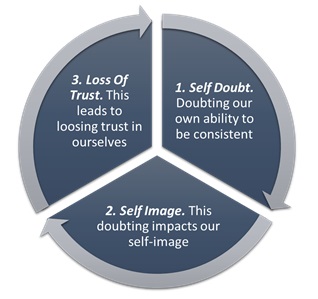
Every single one of us has the potential to be so much more than we are, and throughout our lives, we stumble upon so many amazing ideas and take great initiatives for our growth and well-being, and we also go to great lengths to get started and get things going.
So many great ideas and initiatives just get buried in the ground forever. So many people who have the potential to achieve so much never make it, only because of the lack of consistency. We often have so many positive intentions and thoughts, and we often know what we “should” do to increase the quality of our lives. If only we could consistently follow some of our life’s callings, our lives might transform beyond our imagination. This can also lead to:-
- Self Doubt. Doubting our own ability to be consistent and ability to follow through, leading to people’s image of us being inconsistent.
- Self Image. This doubting impacts our self-image and self-esteem.
- Loss Of Trust. This leads to loosing trust in ourselves, becoming afraid to commit to anything, ending up in a negative self-belief.

Some of the principles for building consistency are:
1. Commit IF You REALLY Want To Do It:. . . . .Often people commit to things in the heat of the moment, and their decision to commit is based on the face value of things. Before committing to anything important, think the following questions through:
- Are you really willing to face the challenges that’ll come along the way?
- Are you willing to go through the learning curve and develop all the necessary skills that you might need along the way?
- Are you willing to take time out for this even if it means making some sacrifices on other things?
- What is your real WHY behind wanting this? Be honest with yourself.
2. Don’t Complicate. Make it Simple and SUSTAINABLE: . . . . . . . . . A lot of people when starting off in something, get into too much fuss and tiny details. They make it way more complex than it should be. Remember, the key to Sustainability is Simplicity. If you get into too much detail in the beginning, trying to make everything perfect, and fretting over tiny details, it will be difficult for you to last long, after the initial hype fades off. First, just get in the habit of getting things going.
3. Choose EFFICIENCY Over CREATIVITY (where needed): . . . . . . . . . . . Creativity – in the right place – is certainly a must and has its own place. But sometimes, unnecessary creativity can affect the efficiency and flow of things, making it difficult to sustain in the long run. Don’t waste your creative efforts in petty things especially as you are starting off. Choose flow and efficiency in routine tasks so that you don’t have to waste your mental energy on the small stuff. Reserve your mental energy and creativity for things that really matter in terms of your progress.
4. Avoid “Paralysis by Analysis”:. . . . . . . . . . .With SO MUCH information out there, many of us get caught up with all the details and analytics. When you analyze things too much, especially when they are in their initial phases and not producing many results you’ll get fed up and eventually give up.
5. Set Realistic Goals And Expectations:. . . . . . . . . . .Many people, after seeing other people’s overnight success stories, expect results too early. They overestimate what they can achieve in 6-12 months. Things take time to develop. The success stories we hear of people who blew-up overnight are exceptional cases, not a norm. Aim the highest, but set realistic goals and expectations.
6. Pace Yourself To Avoid Burnouts:. . . . . . . . . . .The initial hype of things can make us work too hard to the point of burnout. It’s wise to see this beforehand and avoid it. Work hard, but remember to pace yourself and take some time to breathe, enjoy and relax along the way. Switch things up a little up to refresh your mind and spirits.
“You throw a bucket of water on a rock and it doesn’t do anything.
You let a drop of water fall onto a rock everyday and it creates a hole in that rock.”
7. Value PROGRESS Over PERFECTION:. . . . . . . . . . .To attain perfection can take a long time, if there is such a thing as perfection in the human world. When we start out on something enthusiastically, our inner perfectionist and critic tend to come out and pinpoint all the flaws and errors. Things don’t always have to go smoothly and go the way we expect. It’s okay to make mistakes, and it’s not a big deal if we mess things up sometimes.
Also, the “All or Nothing” mindset is very unproductive and inefficient. We cannot always give our best all the time. Sometimes we have to perform on an average level to be able to maintain consistency, just don’t make it a habit. We are humans, we have our ups and downs. Nothing is 100% perfect. If you think that being consistent means to never falter ever again then you need to reshape your perception about consistency.
8. Learn To Say NO:. . . . . . . . . . .Learning to say NO is an essential part of being consistent. It’s very hard for a Yes-Man/Woman to be consistent at something because they are always occupied by things that are not necessary. Prioritize and don’t let any distractions drag you away from your priority tasks. If you made a commitment to a certain thing, keep it high on your priority list and say no to anything that might get in the way. Don’t make promises you can’t keep. Whether it be making promises to self or to other people.
Sometimes life can get in the way no matter how hard we try to commit, and that is totally natural. The thing that determines your consistency is not how perfectly you follow through, but how fast you come back to your commitment if you get off track.
9. Create a System and Automate Your Work:. . . . . . . . . . .Whether you’re seeking consistency in your personal life or professional life, make it a point to set a specific system so that everything clicks, instead of you thinking about the order of thing or the tiny details every time you do something. When you set a system, you don’t have to waste your mental energy thinking or worrying about everyday stuff.
Also, look towards automating as many things as you can through apps and online services. Use technology as your servant and delegate as much work to it as you can. Automation will tremendously simplify your life, save your from being overwhelmed, and free up a lot of time which you can utilize in other important things.
Steps to build the skill of Being Consistent:
Every year people make new resolutions. For the first couple of days, they ride that wave of motivation. They show up, do the work, move on. Another day won. But then the novelty wears off. It doesn’t have to be that way. Being consistent is a skill that can be developed. Here’s one way to build the skill.

Step 1: Choose a Goal: . . . . . . This is the easy part: choose something you want to achieve. You have something already on your mind. Maybe you want to start writing. Or lose weight. To maximize your odds of success, bind it to personality change. You’re not looking to achieve, you want to become. Connect your goal to a personality change to make it permeate. For example, you’re someone who writes, or, a healthy person that eats clean and exercises.
“I want to become_______.”
Step 2: Tie It to an Action: . . . . . .How are you going to reach your goal? What does success look like? This is the rep — the action you’ll be doing consistently to achieve your goal. Focus on the process rather than the outcome. For Example, a writer writes. There’s really nothing else to it. Your action is sitting down to write for 30 minutes every day. A healthy person exercises. Commit to making 10 pushups per day, no matter what. Choose easy actions. First, you need to master showing up, or getting started. The habit of consistency isn’t about grand gestures or quick results. It’s about incremental progress over a long period of time. It’s 1% for years.
“I want to become_______ by ____________ every day/week.”
Step 3: Commit to a Time and Place: . . . . . .It’s now time to set intentions: choosing a time and place to perform your action. The easiest place to start is inserting your new action into your routine. It’s important that you choose a non-negotiable time to practice and be consistent. The location can be as simple as “at the desk” or broader like “the park”. Come out of this step with a time and place for your habit.
“I will become_______ by____________ every day/week at_______ am/pm at_________.”
Step 4: Track Your Progress: . . . . . .You want to make yourself accountable. All you need is a calendar and a marker. It has to be physical and you’ll understand why in a minute. Remember the consistency formula is: “I will become (GOAL) by (ACTION) every day at (TIME) at (LOCATION).” Write your consistency “affirmation” at the top of your calendar. When you practice your habit, draw a big X on top of that day. Every X on your calendar is a vote for who you want to become.
Step 5: Don’t Break the Chain: . . . . . . After a few days, you’ll start seeing a chain of X’s. Visual progress pleases the brain. Keep the chain going. It doesn’t matter if the end result is good or bad, you just do it. No excuses. If you do fail, get back on track as quick as possible. One day is a lapse. Two is the beginning of a new habit — the habit of not being consistent. You’ll struggle. That’s part of the process. Accept it, embrace it, move ahead.
Content Curated By: Dr Shoury Kuttappa

